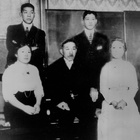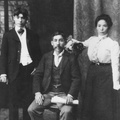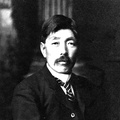Read Part 1 (Tomekichi Homma) >>
What did the village of Steveston look like in the 1880s when the first Japanese fishermen arrived? The village that became Steveston took its name from Manoah Stevens who brought his family from New Brunswick around 1878. In 1880 his son received a large crown land grant, part of which he subdivided into 237 small lots on a grid pattern. Over the next ten years he also sold larger lots for industrial use near the Fraser River.
Steveston was incorporated in 1889. By 1890, 100 lots were sold, and a federal government wharf was built. In 1892, there were 200 names in the British Columbia Directory, which also included a write-up mentioning two hotels, two general stores and 1½ miles of wooden sidewalks. A road to Vancouver had been started and regular steamship connections to Victoria, Vancouver and New Westminster were in operation on the Fraser River.
Japanese fishermen began working for the Phoenix Cannery in Steveston during the mid-1880s. In 1894 it provided land for a Japanese chapel, which also served as a community gathering hall. In 1898 it was being used as a Church-sponsored hospital. Over the years, many Japanese fishermen’s families rented homes on cannery land.
Toyo Takata’s Nikkei Legacy states that the first Japanese working in Vancouver were employed at Hastings Sawmill in 1892. Steveston at the time did not even have a road to Vancouver. It seems improbable that any Japanese was fishing out of Steveston as early as 1882 or 1883, dates given above as when Homma first arrived.1
At that time the village had not even been incorporated. It is not likely that Homma arrived before 1887, the date Takata gives. However, there is no verification that he came in that year. All we can state as fact is that Homma was in Steveston by 1897 when he was elected president of Fureza Gawa Ryoshi Dantai (Fraser River Japanese Fishermen’s Association). Homma himself gives still another date for when he first came as will be seen below.
Many other incorrect statements have been made over the years in various accounts of Homma’s life. Since this article is only interested in establishing that Homma did not arrive in Canada before 1887 there is no need to continue recounting his life after 1901.
Yet one more document is worth presenting, at least in part. The New Canadian, of August 9, 1977, featured a front page article titled, “The Early Pioneers.” It was a translation from a series of recollections from the Kanada Doho Hatten Taikan published in 1922—mentioned above. Roy Ito acted as editor, coordinating seven translators. The article translated was by Tomekichi Honma [sic].
He discusses the history of the first Japanese immigrants as well as his own personal life in Canada. The quotes below focus on his own life, while a few others are included to add colour and context. Below are Homma’s words written in 1922.
Looking Back by Tomekichi Honma [sic]
I came to Canada about thirty-three years ago. As I look at the diaries I have kept all these years, I recall the many incidents and people that comprised the Japanese community in the early days.
When I came to Canada thirty-three years ago (1889), there were very few Japanese. Now there are more than 10,000 living here. Two men who did exceptionally well are Senkichi Tamura and Masajiro Furuya. They came to Canada with only the clothes they wore, worked as labourers, went into business and became rich men. . . .
On July 12, 1886 the Canadian Pacific Railway finally reached Vancouver At that time there were not too many Japanese lived in Canada and not too many white people. By 1892 a few Japanese lived a very rugged life in the bunkhouses. Then eight or nine little shacks were built by the Japanese near Hastings Mill. . . .
In May, 1899 Nagao and I became labour contractors for the C.P.R. The men we recruited were all new to railroad work except for Nakakichi Nakazawa who came from Portland. When Nagao and I had a misunderstanding in March, 1903 I left and Atsuo Hattori from Seattle took my place. . . .
Mitsuhei Yamano and I became partners and started a rooming house. Others who got into this business were Ichitaro Suzuki, Ikuno Murakami and Hikotaro Miyasaki who started a rooming house behind the law courts This was about 1899 or 1900.
I started fishing on a Columbia boat at Steveston in 1892. A man called Yamashita built a half deck onto the Columbia boat. The Columbia boat easily took water in the rain and in the rough sea. The half deck gave shelter to the fishermen and prevented the water from getting into the boat. Within a period of two weeks all Japanese had half decks built. Suga-ju (Jukichi Hayakawa) received the first fishing license. [Independent fishing licence in 1889; Japanese fishermen had worked on contract with the canneries earlier] . . . .
In 1900 the Japanese fishermen were organized into a union. Mr. Yamazaki (present publisher of Tairiku Nippo) became the secretary. [This was really a re-organization of the first Fishermen’s Association that had formed in 1897 with Homma as president. With a new constitution it took on more responsibilities for the whole community. It was referred to as Gyosha Dantai or (Benevolent Society) rather than just a union] . . . .
The Japanese are people of the sea and did not get into farming in Canada until the last ten years. In 1895 Kisuke Mikumi [sic] started farming on Saturna Island. . . Mikumi [sic] started bringing immigrants to work on farms. He worked for Charles Gabriel, a Frenchman, who lived in Victoria. A man called Tsuchiya grew sugar beets in Raymond. He was the first to farm in southern Alberta.
In 1897 Mr. and Mrs. Ranzo Kishimoto (wife’s name is Yoko) started teaching in a makeshift classroom in a house belonging to Mr. Mori on Powell Street. Torasaburo Tanaka and Waichi Kanemura were requested by the Japanese consul, Mr. Shimizu, to act as school trustees. . . .Tencho setsu [the Emperor’s Birthday] was celebrated at the home of Kihei Kinzo Irie acting as chairman. Consul Nose attended dressed in formal court uniform. Banzais were shouted for the Emperor.
* * * * *
Thus Tomekichi Homma clearly states his date of arrival as 1889. Yes, this early immigrant became a Canadian, sank roots and stayed, even if it is clear he could not have arrived in 1883. If not Homma, who arrived earlier?
To be continued >>>
Notes:
1. Rigenda Sumida, “The Japanese in British Columbia,” M.A. thesis, manuscript, UBC Library, 1934.(On page 225, Sumida wrote, “The first Japanese fishermen were found in Steveston in 1885.” but offers no proof.)
*This article was originally published in the Nikkei Image, A publication of the Nikkei National Museum & Cultural Centre (Volume 28, No. 1).
© 2023 Ann-Lee Switzer, Gordon Switzer








